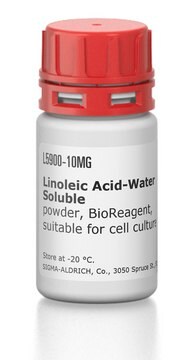O1257
Oleic Acid-Water Soluble
powder, BioReagent, suitable for cell culture
Synonym(s):
Oleic Acid–Cyclodextrin Complex
About This Item
Recommended Products
biological source
synthetic (organic)
Quality Level
product line
BioReagent
form
powder
composition
Oleic acid, ~30 mg/g (balance methyl-β-cyclodextrin)
technique(s)
cell culture | mammalian: suitable
solubility
H2O: 50 mg/mL, clear to slightly hazy
storage temp.
−20°C
SMILES string
CCCCCCCC\C=C/CCCCCCCC(O)=O
InChI
1S/C18H34O2/c1-2-3-4-5-6-7-8-9-10-11-12-13-14-15-16-17-18(19)20/h9-10H,2-8,11-17H2,1H3,(H,19,20)/b10-9-
InChI key
ZQPPMHVWECSIRJ-KTKRTIGZSA-N
Gene Information
human ... SOAT1(6646) , SOAT2(8435)
Application
- to prepare the FFAs (free fatty acids) mixture for cell treatment
- to investigate its effect on the solute carrier family 2 member 4 (SLC2A4)/GLUT4 expression in L6 muscle cells and as potential transcriptional regulators
- in the preparation of fatting media for the induction of in vitro steatosis in primary human hepatocytes
Other Notes
related product
Storage Class Code
10 - Combustible liquids
WGK
WGK 3
Flash Point(F)
Not applicable
Flash Point(C)
Not applicable
Personal Protective Equipment
Certificates of Analysis (COA)
Search for Certificates of Analysis (COA) by entering the products Lot/Batch Number. Lot and Batch Numbers can be found on a product’s label following the words ‘Lot’ or ‘Batch’.
Already Own This Product?
Find documentation for the products that you have recently purchased in the Document Library.
Customers Also Viewed
Articles
Fatty acids of the n-3, n-6 and n-9 families are important supplements for cell culture systems. They are important in cell culture systems used to biomanufacture heterologous proteins, such as monoclonal antibodies.
How the unsaturated fatty acid, oleic acid and other cell culture components affect the performance of serum-free, protein-free cell culture systems used for biomanufacturing heterologous proteins including monoclonal antibodies.
Our team of scientists has experience in all areas of research including Life Science, Material Science, Chemical Synthesis, Chromatography, Analytical and many others.
Contact Technical Service








